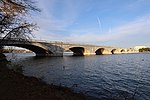Columbia Island (District of Columbia)

Lady Bird Johnson Park, formerly known as Columbia Island until 1968, is an island located in the Potomac River in Washington, D.C., in the United States. It formed naturally as an extension of Analostan Island in the latter part of the 1800s, and over time erosion and flooding severed it from Analostan, now known as Theodore Roosevelt Island. The U.S. federal government deposited material dredged from the Potomac River on the island between 1911 and 1922, and again from 1925 to 1927. The island was also reshaped by the government at this time "to serve as the western terminus of Arlington Memorial Bridge and a symbolic entrance into the nation’s capital." Located within the park are the Lyndon Baines Johnson Memorial Grove, Navy – Merchant Marine Memorial, and the Columbia Island Marina. The island, park, memorials, and marina are part of the George Washington Memorial Parkway and administered by the National Park Service.
Excerpt from the Wikipedia article Columbia Island (District of Columbia) (License: CC BY-SA 3.0, Authors, Images).Columbia Island (District of Columbia)
27 Trail, Washington
Geographical coordinates (GPS) Address Nearby Places Show on map
Geographical coordinates (GPS)
| Latitude | Longitude |
|---|---|
| N 38.8823342 ° | E -77.0571996 ° |
Address
27 Trail
27 Trail
20301 Washington
District of Columbia, United States
Open on Google Maps








